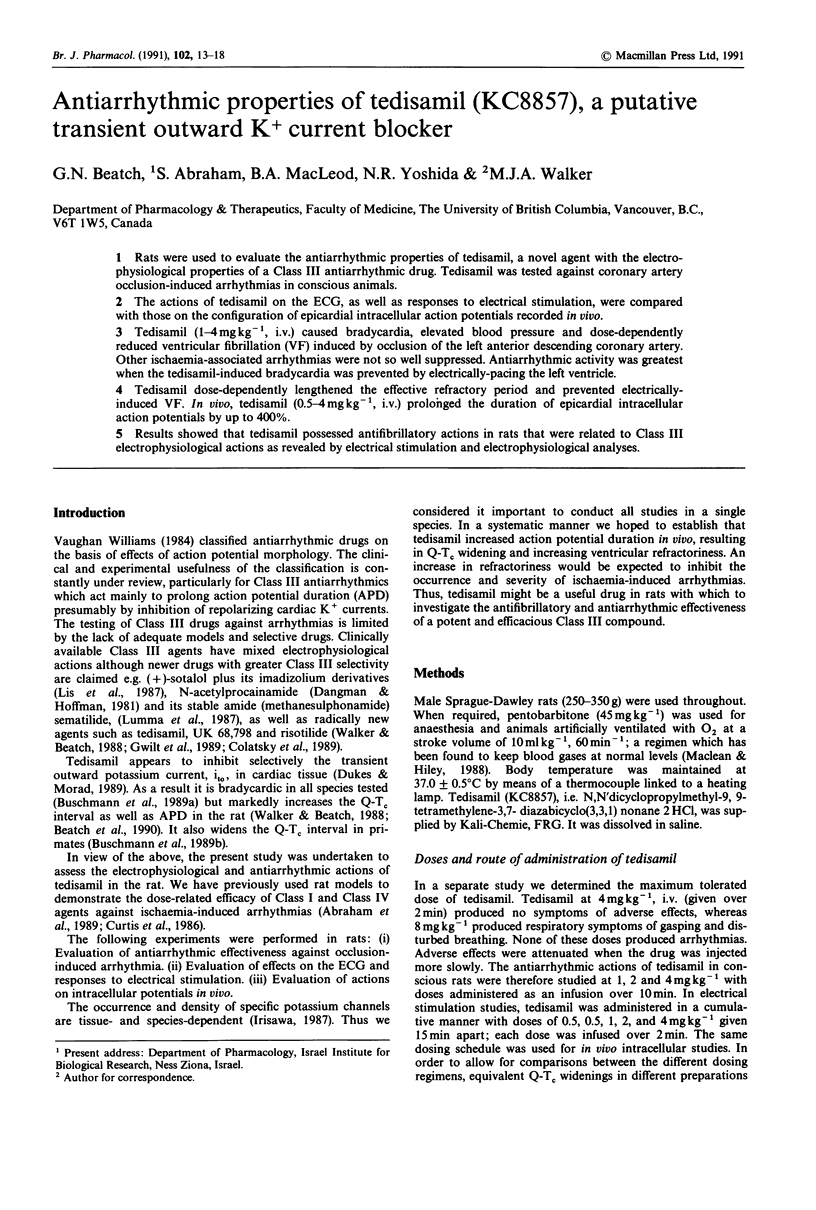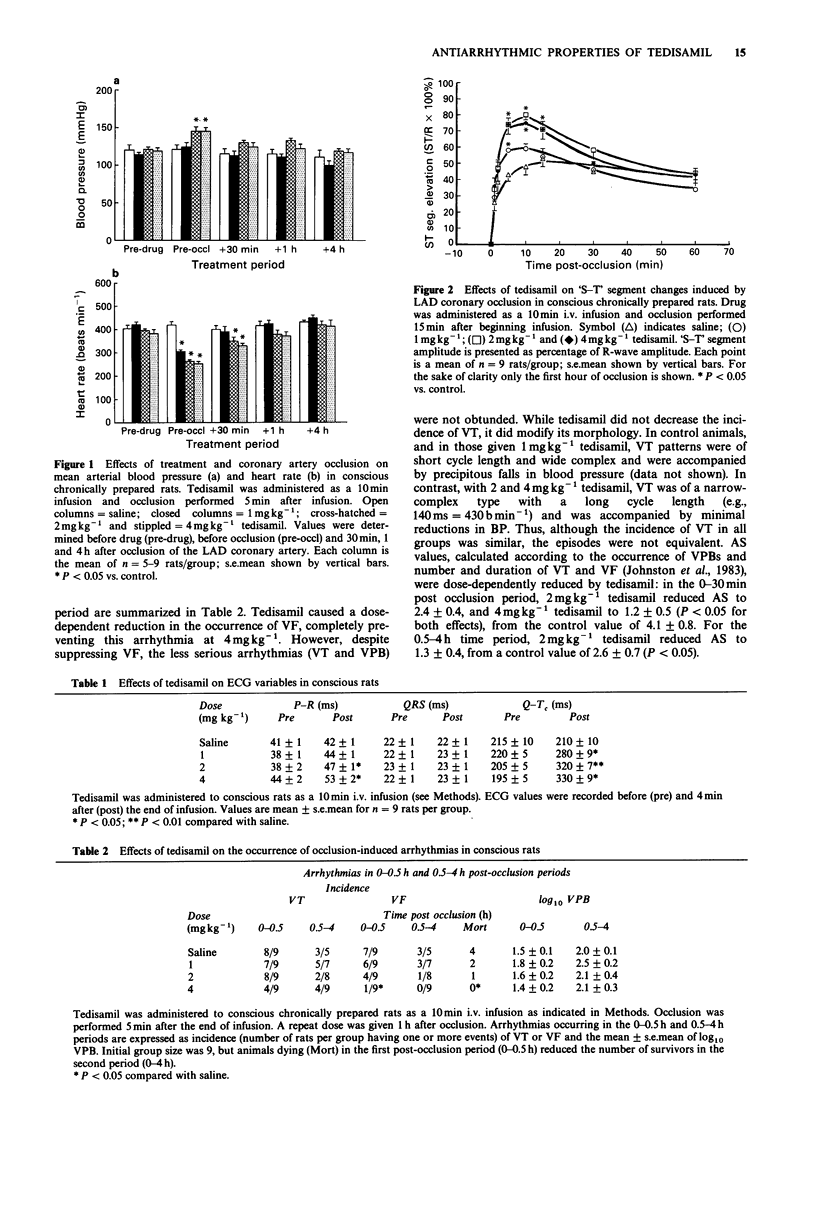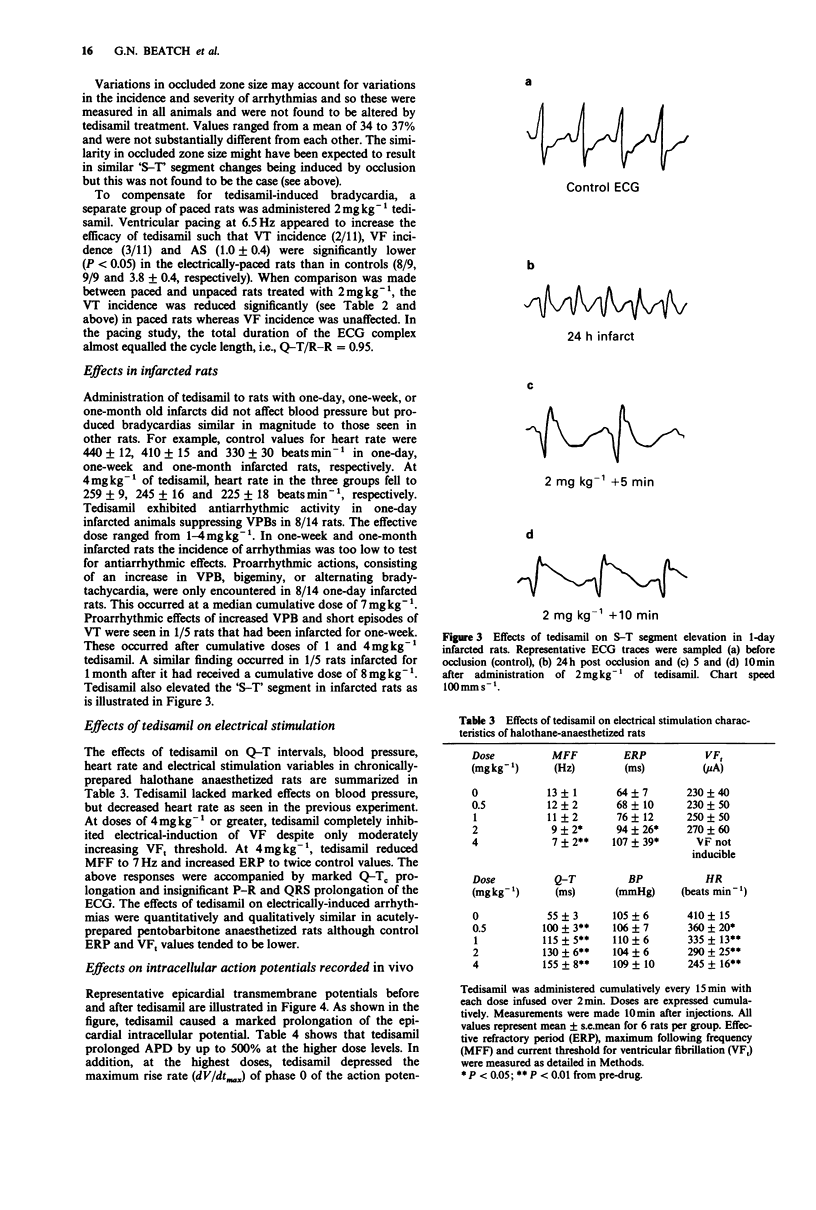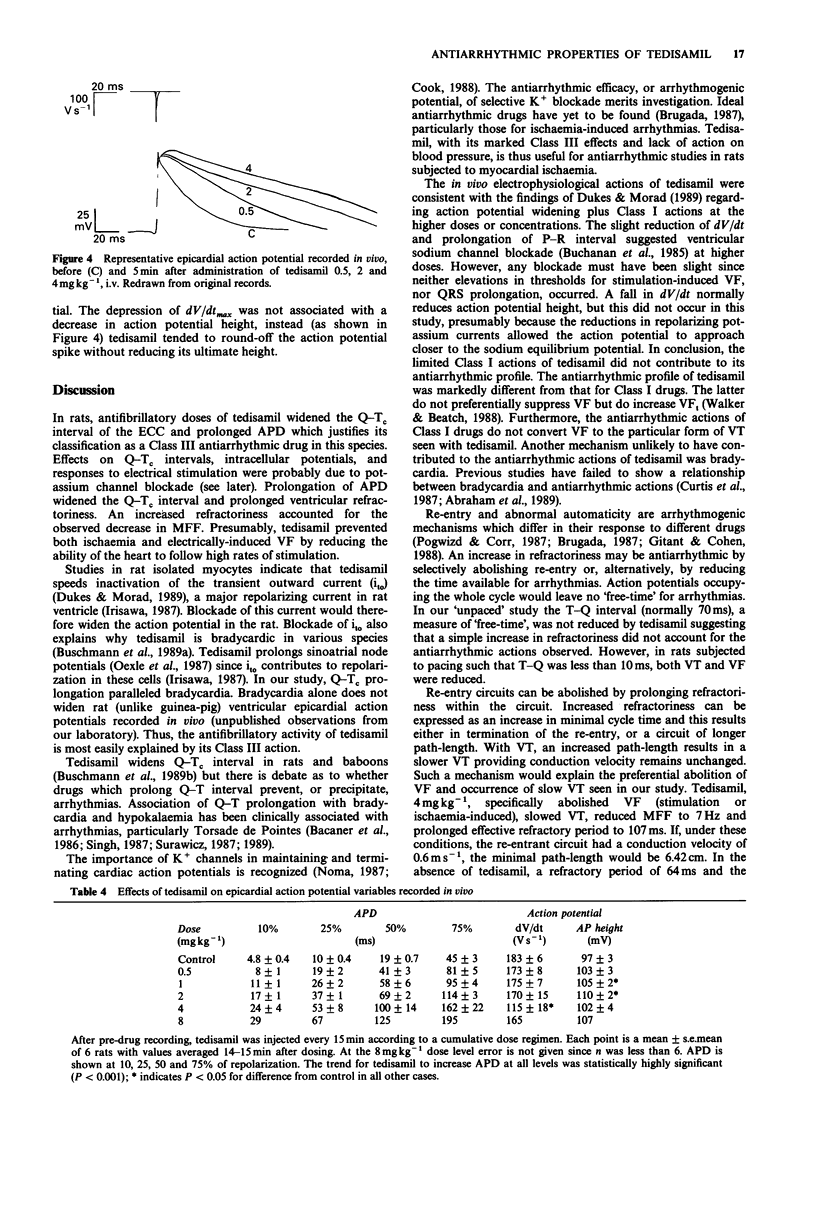Abstract
1. Rats were used to evaluate the antiarrhythmic properties of tedisamil, a novel agent with the electrophysiological properties of a Class III antiarrhythmic drug. Tedisamil was tested against coronary artery occlusion-induced arrhythmias in conscious animals. 2. The actions of tedisamil on the ECG, as well as responses to electrical stimulation, were compared with those on the configuration of epicardial intracellular action potentials recorded in vivo. 3. Tedisamil (1-4 mg kg-1, i.v.) caused bradycardia, elevated blood pressure and dose-dependently reduced ventricular fibrillation (VF) induced by occlusion of the left anterior descending coronary artery. Other ischaemia-associated arrhythmias were not so well suppressed. Antiarrhythmic activity was greatest when the tedisamil-induced bradycardia was prevented by electrically-pacing the left ventricle. 4. Tedisamil dose-dependently lengthened the effective refractory period and prevented electrically-induced VF. In vivo, tedisamil (0.5-4 mg kg-1, i.v.) prolonged the duration of epicardial intracellular action potentials by up to 400%. 5. Results showed that tedisamil possessed antifibrillatory actions in rats that were related to Class III electrophysiological actions as revealed by electrical stimulation and electrophysiological analyses.
Full text
PDF





Selected References
These references are in PubMed. This may not be the complete list of references from this article.
- Abraham S., Beatch G. N., MacLeod B. A., Walker M. J. Antiarrhythmic properties of tetrodotoxin against occlusion-induced arrhythmias in the rat: a novel approach to the study of the antiarrhythmic effects of ventricular sodium channel blockade. J Pharmacol Exp Ther. 1989 Dec;251(3):1166–1173. [PubMed] [Google Scholar]
- Bacaner M. B., Clay J. R., Shrier A., Brochu R. M. Potassium channel blockade: A mechanism for suppressing ventricular fibrillation. Proc Natl Acad Sci U S A. 1986 Apr;83(7):2223–2227. doi: 10.1073/pnas.83.7.2223. [DOI] [PMC free article] [PubMed] [Google Scholar]
- Beatch G. N., MacLeod B. A., Abraham S., Walker M. J. The in vivo electrophysiological actions of the new potassium channel blockers, tedisamil and UK 68,798. Proc West Pharmacol Soc. 1990;33:5–8. [PubMed] [Google Scholar]
- Brugada P. New antiarrhythmic drugs: still looking for the ideal one. Eur Heart J. 1987 Aug;8 (Suppl 500):91–94. doi: 10.1093/eurheartj/8.suppl_d.91. [DOI] [PubMed] [Google Scholar]
- Buchanan J. W., Jr, Saito T., Gettes L. S. The effects of antiarrhythmic drugs, stimulation frequency, and potassium-induced resting membrane potential changes on conduction velocity and dV/dtmax in guinea pig myocardium. Circ Res. 1985 May;56(5):696–703. doi: 10.1161/01.res.56.5.696. [DOI] [PubMed] [Google Scholar]
- Cook N. S. The pharmacology of potassium channels and their therapeutic potential. Trends Pharmacol Sci. 1988 Jan;9(1):21–28. doi: 10.1016/0165-6147(88)90238-6. [DOI] [PubMed] [Google Scholar]
- Curtis M. J., Walker M. J. Quantification of arrhythmias using scoring systems: an examination of seven scores in an in vivo model of regional myocardial ischaemia. Cardiovasc Res. 1988 Sep;22(9):656–665. doi: 10.1093/cvr/22.9.656. [DOI] [PubMed] [Google Scholar]
- Curtis M. J., Walker M. J. The mechanism of action of the optical enantiomers of verapamil against ischaemia-induced arrhythmias in the conscious rat. Br J Pharmacol. 1986 Sep;89(1):137–147. doi: 10.1111/j.1476-5381.1986.tb11129.x. [DOI] [PMC free article] [PubMed] [Google Scholar]
- Dangman K. H., Hoffman B. F. In vivo and in vitro antiarrhythmic and arrhythmogenic effects of N-acetyl procainamide. J Pharmacol Exp Ther. 1981 Jun;217(3):851–862. [PubMed] [Google Scholar]
- Dukes I. D., Morad M. Tedisamil inactivates transient outward K+ current in rat ventricular myocytes. Am J Physiol. 1989 Nov;257(5 Pt 2):H1746–H1749. doi: 10.1152/ajpheart.1989.257.5.H1746. [DOI] [PubMed] [Google Scholar]
- Gintant G. A., Cohen I. S. Advances in cardiac cellular electrophysiology: implications for automaticity and therapeutics. Annu Rev Pharmacol Toxicol. 1988;28:61–81. doi: 10.1146/annurev.pa.28.040188.000425. [DOI] [PubMed] [Google Scholar]
- Howard P. G., Abraham S., Courtice I. D., Walker M. J. Further studies into the ECG effects of tedisamil (KC 8857) in rats. Proc West Pharmacol Soc. 1989;32:183–183. [PubMed] [Google Scholar]
- Irisawa H. Membrane currents in cardiac pacemaker tissue. Experientia. 1987 Dec 1;43(11-12):1131–1135. doi: 10.1007/BF01945510. [DOI] [PubMed] [Google Scholar]
- Johnston K. M., MacLeod B. A., Walker M. J. Responses to ligation of a coronary artery in conscious rats and the actions of antiarrhythmics. Can J Physiol Pharmacol. 1983 Nov;61(11):1340–1353. doi: 10.1139/y83-193. [DOI] [PubMed] [Google Scholar]
- Lis R., Morgan T. K., Jr, DeVita R. J., Davey D. D., Lumma W. C., Jr, Wohl R. A., Diamond J., Wong S. S., Sullivan M. E. Synthesis and antiarrhythmic activity of novel 3-alkyl-1-[omega-[4-[(alkylsulfonyl)amino]phenyl]-omega- hydroxyalkyl]-1H-imidazolium salts and related compounds. J Med Chem. 1987 Apr;30(4):696–704. doi: 10.1021/jm00387a020. [DOI] [PubMed] [Google Scholar]
- Lumma W. C., Jr, Wohl R. A., Davey D. D., Argentieri T. M., DeVita R. J., Gomez R. P., Jain V. K., Marisca A. J., Morgan T. K., Jr, Reiser H. J. Rational design of 4-[(methylsulfonyl)amino]benzamides as class III antiarrhythmic agents. J Med Chem. 1987 May;30(5):755–758. doi: 10.1021/jm00388a001. [DOI] [PubMed] [Google Scholar]
- MacLean M. R., Hiley C. R. Effect of artificial respiratory volume on the cardiovascular responses to an alpha 1- and an alpha 2-adrenoceptor agonist in the air-ventilated pithed rat. Br J Pharmacol. 1988 Apr;93(4):781–790. doi: 10.1111/j.1476-5381.1988.tb11463.x. [DOI] [PMC free article] [PubMed] [Google Scholar]
- Pogwizd S. M., Corr P. B. Reentrant and nonreentrant mechanisms contribute to arrhythmogenesis during early myocardial ischemia: results using three-dimensional mapping. Circ Res. 1987 Sep;61(3):352–371. doi: 10.1161/01.res.61.3.352. [DOI] [PubMed] [Google Scholar]
- Singh B. N., Nademanee K. Sotalol: a beta blocker with unique antiarrhythmic properties. Am Heart J. 1987 Jul;114(1 Pt 1):121–139. doi: 10.1016/0002-8703(87)90316-4. [DOI] [PubMed] [Google Scholar]
- Surawicz B. Electrophysiologic substrate of torsade de pointes: dispersion of repolarization or early afterdepolarizations? J Am Coll Cardiol. 1989 Jul;14(1):172–184. doi: 10.1016/0735-1097(89)90069-7. [DOI] [PubMed] [Google Scholar]
- Surawicz B. The QT interval and cardiac arrhythmias. Annu Rev Med. 1987;38:81–90. doi: 10.1146/annurev.me.38.020187.000501. [DOI] [PubMed] [Google Scholar]
- Vaughan Williams E. M. A classification of antiarrhythmic actions reassessed after a decade of new drugs. J Clin Pharmacol. 1984 Apr;24(4):129–147. doi: 10.1002/j.1552-4604.1984.tb01822.x. [DOI] [PubMed] [Google Scholar]
- Walker M. J., Beatch G. N. Electrically induced arrhythmias in the rat. Proc West Pharmacol Soc. 1988;31:167–170. [PubMed] [Google Scholar]
- Walker M. J., Curtis M. J., Hearse D. J., Campbell R. W., Janse M. J., Yellon D. M., Cobbe S. M., Coker S. J., Harness J. B., Harron D. W. The Lambeth Conventions: guidelines for the study of arrhythmias in ischaemia infarction, and reperfusion. Cardiovasc Res. 1988 Jul;22(7):447–455. doi: 10.1093/cvr/22.7.447. [DOI] [PubMed] [Google Scholar]


